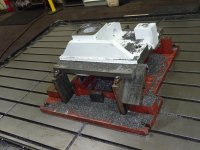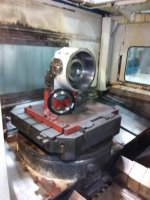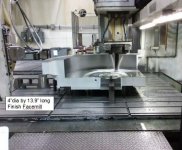implmex
Diamond
- Joined
- Jun 23, 2002
- Location
- Vancouver BC Canada
Hi All:
Hers's a subject Keith (my business partner) and I often disagree on: I will program a part to use the biggest cutters I can fit into the geometry whereas he believes in using smaller cutters and running them faster and at higher feedrates to maintain the same chipload.
I will also often prefer to stuff down a big cutter to hog out; then pick out the corners where he will "high speed-constant chipload" mill everything with the same cutter to save the cost of setup, the cost of the first rougher , and the toolchange time.
Keith claims the MRR is the same therefore the productivity is the same or better once he factors in those extra costs.
So he believes using smaller cheaper cutters confers some benefit beside the cost of the cutters, which follow:
He claims better finishes.
He prefers to interpolate generously around internal radii; I will program a 0.135" internal rad with a 1/4" cutter whereas he will use a 3/16 or 5/32 or even 1/8" cutter.
He claims less cutter pressure therefore better geometric fidelity.
His arguments are not unreasonable, but I believe them to be incorrect in a couple of ways:
First I can use a deeper DOC so my MRR should be faster.
Second I can use a bigger radial stepover so my MRR should be faster.
Third I'm using a stiffer cutter and my finishing passes are very small with correspondingly small tool pressures, so my geometric fidelity should be equivalent except with very flimsy features.
Fourth my cutter uses each flute fewer times to cut the same amount of material so my cutter should last longer, thereby making up for its higher price..
So who is correct?
I realize of course much depends on the situation, but assuming a rigid mill and a well clamped block with reasonably robust features...
As a general principle, do you typically pick my way or Keith's way when you start cutting on a job?
Why do you make the choices you do?
Cheers
Marcus
Implant Mechanix • Design & Innovation > HOME
www.vancouverwireedm.com
Hers's a subject Keith (my business partner) and I often disagree on: I will program a part to use the biggest cutters I can fit into the geometry whereas he believes in using smaller cutters and running them faster and at higher feedrates to maintain the same chipload.
I will also often prefer to stuff down a big cutter to hog out; then pick out the corners where he will "high speed-constant chipload" mill everything with the same cutter to save the cost of setup, the cost of the first rougher , and the toolchange time.
Keith claims the MRR is the same therefore the productivity is the same or better once he factors in those extra costs.
So he believes using smaller cheaper cutters confers some benefit beside the cost of the cutters, which follow:
He claims better finishes.
He prefers to interpolate generously around internal radii; I will program a 0.135" internal rad with a 1/4" cutter whereas he will use a 3/16 or 5/32 or even 1/8" cutter.
He claims less cutter pressure therefore better geometric fidelity.
His arguments are not unreasonable, but I believe them to be incorrect in a couple of ways:
First I can use a deeper DOC so my MRR should be faster.
Second I can use a bigger radial stepover so my MRR should be faster.
Third I'm using a stiffer cutter and my finishing passes are very small with correspondingly small tool pressures, so my geometric fidelity should be equivalent except with very flimsy features.
Fourth my cutter uses each flute fewer times to cut the same amount of material so my cutter should last longer, thereby making up for its higher price..
So who is correct?
I realize of course much depends on the situation, but assuming a rigid mill and a well clamped block with reasonably robust features...
As a general principle, do you typically pick my way or Keith's way when you start cutting on a job?
Why do you make the choices you do?
Cheers
Marcus
Implant Mechanix • Design & Innovation > HOME
www.vancouverwireedm.com









